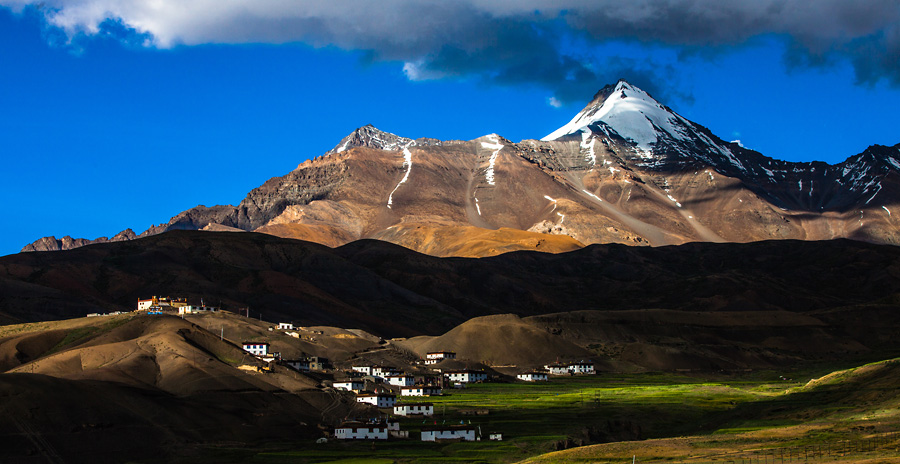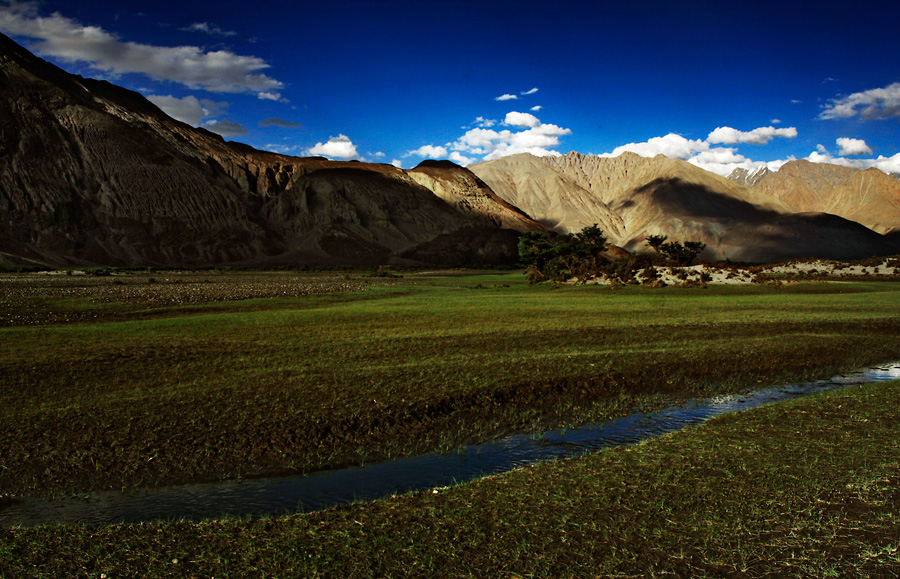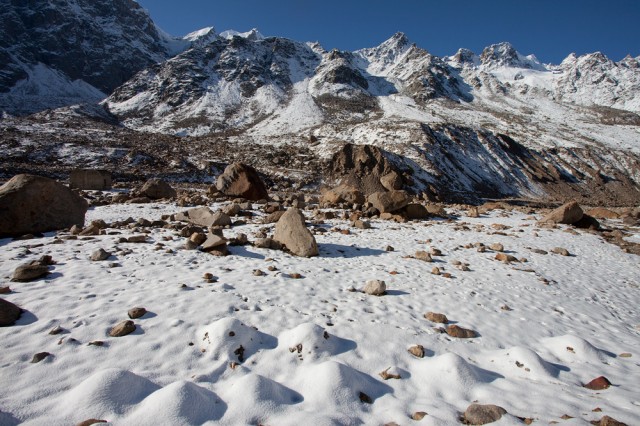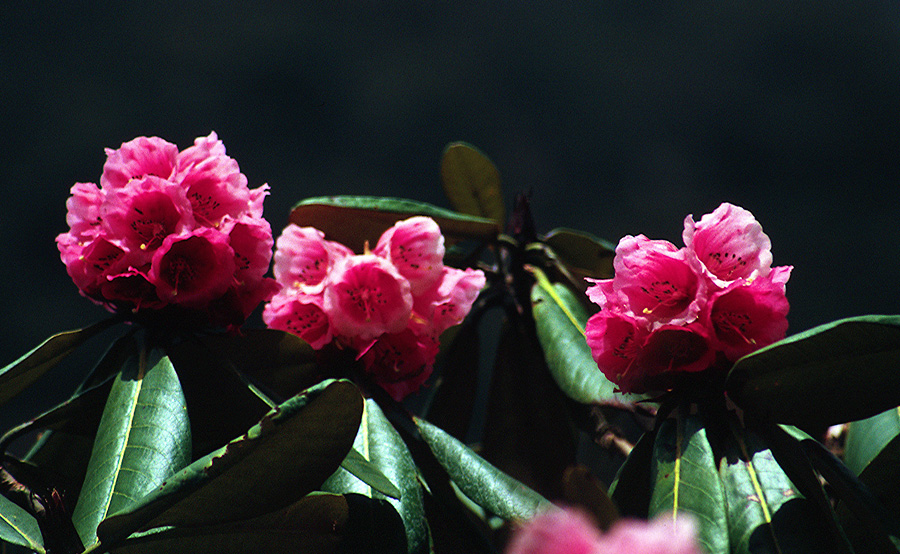
How is it to live in a village at the base of a 20,000 feet high mountain forever covered in snow? How does one endure winter temperatures that can go down to -20C or lower? What is like to be in the company of yaks in summer and snow-leopards in winter? What does it take to survive in such a place for centuries, when modern facilities did not exist? I went to Langza to find answers.

Langza Village, with 6,300m high Chau Chau Kang Nilda Peak in the background.
Langza is no ordinary village. Located above 14,000 feet in Spiti Valley at the crossroads between Tibet and India, where the sun shines strongly over a brown treeless mountainscape in summers, where no rain falls during the monsoons and the winter’s snow can hide your footprints for four months, people have lived for a millennium with little interaction with the outside world. Before the modern world could connect with the people of Spiti, they lived an isolated, nearly self-subsistent life depending on their crop of barley for cereals and livestock for every other needs. They worked hard through the summer months, growing the year’s food and herding their sheep into the high-altitude meadows. The barren winters were for a slower pace of life, for festivities, celebrations and weddings, where barley chang flowed free from a yak-horn cup and the feet moved freely to the rhythm of drums. Only the strongest and the bravest travelled far and wide, to procure salt for the meal and timber for the houses. Everything else was made at home.
I found my ideal do-nothing place in Ladakh’s Nubra Valley. It was a place for long walks in the meadows, reading books with a cup of tea in a garden chair, eating seabuckthorn fruits on the riverbed, relishing apricots straight off the tree, hiding behind the bush watching a herd of Bactrian Camel in the wild, chasing shepherds, walking along the river and watching sunsets while listening to sweet sound of the flow. The days in Nubra were filled with activity and yet I wasn’t really doing anything.
A wise man once said, “Happiness is like a butterfly which, when pursued, is always beyond our grasp, but which, if you will sit down quietly, may alight upon you.” Travelling has some semblance with this statement. If we run from place to place seeking excitement and new experiences, those pleasures always seems to be someplace other than where we are. We humans need change of place at times, but making it a mission to keep changing places probably doesn’t work. The proverbial butterfly requires that you rest.

That place to rest, I found in Hunder. It’s a tiny village in Ladakh’s Nubra Valley housing a few dozen families, and when I went there seven years ago, had only a few dozen tourists. My guest house had a room big enough to play badminton, and outside in the garden, you could actually play football. The garden, however, was put to a more idyllic pursuit. With a book in one hand and a cup of tea in the other, I could sit under the apricot trees and while away the entire day, sometime shifting into the sun and sometimes returning to shade. And when I had enough of the book, there were other hedonistic pursuits that are hallmark of an aimless traveller.

It takes a lot to dazzle a seasoned traveller. After years of travelling to extraordinary places with unsurpassed beauty–rocky seashores, highland meadows, snowy slopes, river valleys, abloom wilderness, pristine lakes and silent woods–a jadedness slips into the once curious explorer. Yet, the traveller often continues to travel and see places as the addiction can’t be curtailed. And much like any other addiction, the high isn’t experienced anymore even when it is impossible to stop. There are times in my journeys where I have felt something amiss. Luxury never feels like it should, streets in a new city do not have the excitement that it had, the waves from the sea don’t seem to have crests and a new experience doesn’t seem new anymore. But there are always places that make you indefatigable, refresh and rejuvenate time and again, and never lets familiarity dominate the spirit. When I think of it, one place rules the mind space – Himalayas.
It is more than a decade since I have been travelling in the Himalayas, seeking its length and breadth, going into the expansive snow-fields of Arunachal, happy kingdom of Bhutan, evergreen foothills of Sikkim, deep valleys of Uttarakhand, wooded Himachal and deserted Ladakh. Each visit is demanding on the body, making me endure the thin air, brave the cold, bear with the aching muscles and survive the lengthy road journeys. Despite all this, the mountains fill the eyes with their grandeur, instill a sense of peace and perpetual awe in the mind. There is no getting tired of Himalayas. Here is a collection of cherished moments that have lingered over the years from many visits to the Himalayas.
Walking in a forest full of colourful rhodondron flowers in Sikkim
On my very first visit to Himalayas, I decided to make a moderately difficult trek to Gochela Pass in Sikkim. I was unprepared and did not know what to expect, and took things the way they came as we trekked up. On the second day of the trek, crossing above ten-thousand feet where the vegetation had long since changed from tropical to coniferous, even the deodars vanished and the woods were filled with rhododendron trees. It was summer, a time for the flowers to bloom. The trees generously bore bunches of pink flowers and splashed their presence in an otherwise green expanse. The sudden splurge of colours numbed my mind, paused my feet and left me mystified. It was a spectacle no less then seeing a star-studded sky on a clear moonless night.

I walked in the company of rhododendrons for several hours, admiring every bouquet that stretched towards me, often looking down at my feet and seeing with a sense of wonder the splash of colours that covered the forest floor. I wanted that moment to last forever. Little else mattered.




